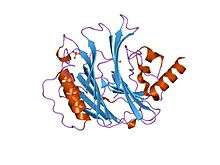Cytotoxic necrotising factor family
| CNF1 | |||||||||
|---|---|---|---|---|---|---|---|---|---|
 crystal structure of the inactive c866s mutant of the catalytic domain of e. coli cytotoxic necrotizing factor 1 | |||||||||
| Identifiers | |||||||||
| Symbol | CNF1 | ||||||||
| Pfam | PF05785 | ||||||||
| InterPro | IPR008430 | ||||||||
| SCOP | 1hzg | ||||||||
| SUPERFAMILY | 1hzg | ||||||||
| |||||||||
In molecular biology, the cytotoxic necrotising factor family of proteins includes bacterial cytotoxic necrotising factor proteins and the related dermonecrotic toxin (DNT) from Bordetella species. Cytotoxic necrotizing factor 1 (CNF1) is a toxin whose structure from Escherichia coli revealed a 4-layer alpha/beta/beta/alpha structure containing mixed beta-sheets.[1] CNF1 is expressed in strains of E. coli causing uropathogenic and neonatal meningitis. CNF1 alters host cell actin cytoskeleton and promotes bacterial invasion of the blood–brain barrier endothelial cells.[2] CNF1 belongs to a unique group of large cytotoxins that cause constitutive activation of Rho guanosine triphosphatases (GTPases), which are key regulators of the actin cytoskeleton .
Bordetella dermonecrotic toxin (DNT) stimulates the assembly of actin stress fibres and focal adhesions by deamidating or polyaminating Gln63 of the small GTPase Rho. DNT is an A-B toxin composed of an N-terminal receptor-binding (B) domain and a C-terminal enzymatically active (A) domain.[3]
References
- ↑ Buetow L, Flatau G, Chiu K, Boquet P, Ghosh P (July 2001). "Structure of the Rho-activating domain of Escherichia coli cytotoxic necrotizing factor 1". Nat. Struct. Biol. 8 (7): 584–8. doi:10.1038/89610. PMID 11427886.
- ↑ Landraud L, Gibert M, Popoff MR, Boquet P, Gauthier M (March 2003). "Expression of cnf1 by Escherichia coli J96 involves a large upstream DNA region including the hlyCABD operon, and is regulated by the RfaH protein". Mol. Microbiol. 47 (6): 1653–67. doi:10.1046/j.1365-2958.2003.03391.x. PMID 12622819.
- ↑ Matsuzawa T, Kashimoto T, Katahira J, Horiguchi Y (July 2002). "Identification of a receptor-binding domain of Bordetella dermonecrotic toxin". Infect. Immun. 70 (7): 3427–32. doi:10.1128/iai.70.7.3427-3432.2002. PMC 128056
 . PMID 12065482.
. PMID 12065482.
This article incorporates text from the public domain Pfam and InterPro IPR008430